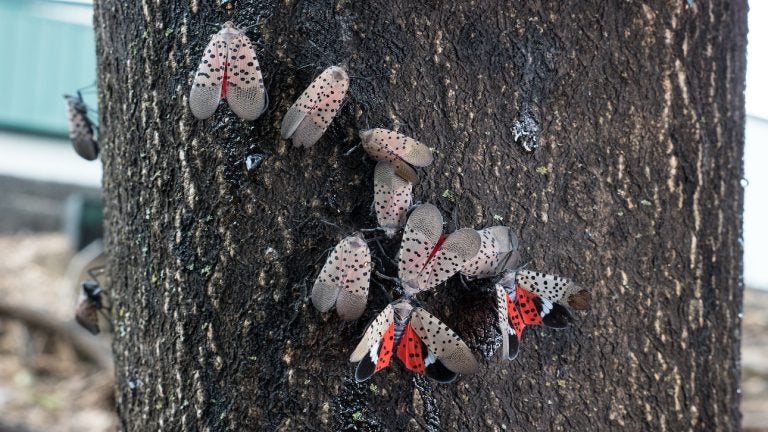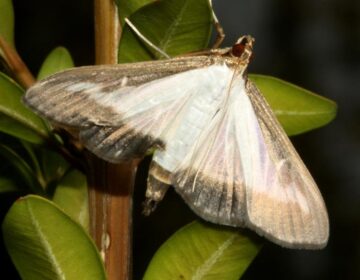In Pa., spotted lanternflies’ knack for hitchhiking is proving crucial to their staying power
The invasive insect appeared in Pennsylvania 10 years ago and continues to spread west, as far away as Illinois.
Listen 1:39
The spotted lanternfly is a destructive insect that feeds on a wide range of fruit, ornamental, and hardwood trees, including grapes, apples, walnut, and oak. (Lance Cheung/USDA)
From Philly and the Pa. suburbs to South Jersey and Delaware, what would you like WHYY News to cover? Let us know!
Spotted lanternflies are back in the Philly region, and in the 10 years since they first appeared in Pennsylvania, scientists have learned important details about the damage they cause — and what makes them so effective.
Shannon Powers, press secretary for the Pennsylvania Department of Agriculture, said the good news is that they do not damage crops as much as scientists had feared 10 years ago.
“They don’t damage, for example, row crops … corn and wheat and those kinds of things … They don’t damage mature hardwoods. They tend to feed on immature trees and young plants,” she said.
However, Powers said the lanternflies can extensively damage grapevines, posing a big threat to vineyards. She added that Pittsburgh is being swarmed with lanternflies this year, like Philadelphia was a few years ago. The department is keeping a close watch to prevent them from spreading to the growing wine industry in Erie.
“Pittsburgh looks a little bit like Philadelphia did maybe three years ago. They’re seeing lanternflies everywhere,” she said. “They’re hitting people in Pittsburgh in the face.”
Since making their U.S. debut in Berks County, Pennsylvania in 2014, lanternflies have spread across the country to 16 other states, recently as far west as Illinois. Now, scientists have a better sense of how they accomplished that feat, despite the fact that they are not very good at flying; they glide more than fly.
Johanna Elsensohn, an applied ecologist at the U.S. Department of Agriculture, first saw spotted lanternflies in Reading, Pennsylvania, six years ago, including some that were crawling over cars and tour buses.
“When we were driving away in our tour bus, one of the spotted lanternflies was just stuck on our window on the outside, just riding along with us for a little bit.”
So she wondered how good they are at hitching rides on cars.
As an experiment, she put spotted lanternflies in various stages of life on a USDA car. She blasted these lanternflies with fans blowing wind of up to 62 miles per hour, to simulate highway conditions.
Even at maximum wind speed, the insects, at all life stages, could hang on to at least one part of the car.
“And that’s really bad news because females could be mated at this stage. So if they travel on a vehicle … this one female can found a new population by herself.”
But, how well the insects could hang on to a car depended on the size of the bug and where they were. The tiny nymphs, insects that have yet to become adults with wings; and young adult insects, were the best at hanging on to a car. The car’s wiper blades, and cowl (the space between a car’s windshield and hood) were best for hitchhiking lanternflies.
This is the first study to test an insect’s hitchhiking abilities, and Elsensohn said the findings and experimental setup could also be useful for fighting other invasive bugs, like the emerald ash borer.
She is working on a follow up study to predict where new lanternfly populations are likely to appear, based on traffic patterns and data on where the lanternfly’s preferred host trees are.
She said the good news is that it appears the lanternflies cannot stand much heat, so they may not get much further south than North Carolina. But the bad news is that the U.S. will never completely eradicate them; they are here to stay.
“It’s continuing to spread and so if we had any chance of eradicating it, it was while it was only in Pennsylvania,” she said. “So I think this is just something that we can just slow the spread and mitigate the damage as much as possible.”
Other USDA research also revealed a potential weakness: Lanternflies are attracted to 60Hz vibrations, which is the frequency at which most power lines in the U.S. carry electricity. That could lead to future methods to spot and trap lanternflies.
And as much as Powers and Elsensohn are reluctant to encourage people to kill living creatures, they said people should continue to kill lanternflies.

Get daily updates from WHYY News!
WHYY is your source for fact-based, in-depth journalism and information. As a nonprofit organization, we rely on financial support from readers like you. Please give today.






